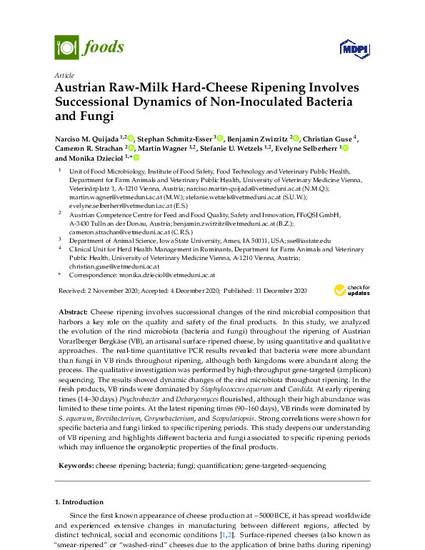
Cheese ripening involves successional changes of the rind microbial composition that harbors a key role on the quality and safety of the final products. In this study, we analyzed the evolution of the rind microbiota (bacteria and fungi) throughout the ripening of Austrian Vorarlberger Bergkäse (VB), an artisanal surface-ripened cheese, by using quantitative and qualitative approaches. The real-time quantitative PCR results revealed that bacteria were more abundant than fungi in VB rinds throughout ripening, although both kingdoms were abundant along the process. The qualitative investigation was performed by high-throughput gene-targeted (amplicon) sequencing. The results showed dynamic changes of the rind microbiota throughout ripening. In the fresh products, VB rinds were dominated by Staphylococcus equorum and Candida. At early ripening times (14–30 days) Psychrobacter and Debaryomyces flourished, although their high abundance was limited to these time points. At the latest ripening times (90–160 days), VB rinds were dominated by S. equorum, Brevibacterium, Corynebacterium, and Scopulariopsis. Strong correlations were shown for specific bacteria and fungi linked to specific ripening periods. This study deepens our understanding of VB ripening and highlights different bacteria and fungi associated to specific ripening periods which may influence the organoleptic properties of the final products.
Available at: http://works.bepress.com/stephan-schmitz-esser/53/

This article is published as Quijada, Narciso M., Stephan Schmitz-Esser, Benjamin Zwirzitz, Christian Guse, Cameron R. Strachan, Martin Wagner, Stefanie U. Wetzels, Evelyne Selberherr, and Monika Dzieciol. "Austrian Raw-Milk Hard-Cheese Ripening Involves Successional Dynamics of Non-Inoculated Bacteria and Fungi." Foods 9, no. 12 (2020): 1851. doi: 10.3390/foods9121851.